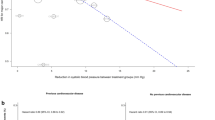Abstract
The randomised clinical trial has, justifiably, become the premier research technique by which the efficacy and, to a lesser extent, safety of hypertensive therapy are established. Through blinding and randomisation, the influence of potentially confounding factors is minimised. In these circumstances, a comparison of outcomes with an identical control group permits an assessment of the impact of the intervention. Useful as this strategy has been in establishing a scientific basis for blood pressure reduction, the process has limitations — particularly in the comparison of different antihypertensive drugs. It may not always be appropriate to apply the result of a clinical trial to the individual patient. Since most participants in these trials do not experience an endpoint, the effect of the intervention probably will not be experienced by most patients who fit the entry criteria of the study. Moreover, the risk of cardiovascular events is unevenly distributed among trial participants even though they have similar blood pressures and, thus, the potential for actual benefit likewise varies depending upon absolute cardiovascular risk. Finally, unrecognised mechanistic differences may produce different results, particularly when comparing mechanistically different drugs, among patients heterogeneous in terms of pathophysiology of blood pressure control. For these reasons, and others, it is likely that the net results of a trial mask substantial outcome differences hidden within the overall study group. In short, the average result may not apply to many patients, even when they meet the criteria for participation in the study. This is not an argument against clinical trials but rather a recognition that clinical practice must not be guided exclusively by epidemiological data but, in addition, by all the information that derives from pathophysiology and pharmacology.

Similar content being viewed by others
References
Collins R, Peto R, MacMahon S, et al. Blood pressure, stroke, and coronary heart disease. Part 2, short-term reductions in blood pressure: overview of randomized drug trials in their epidemiological context. Lancet 1990; 335: 827–38
Veterans Administration Cooperative Study Group on Antihypertensive Agents. Effects of treatment on morbidity in hypertension: results in patients with diastolic blood pressures averaging 115 through 129 mm Hg. JAMA 1967; 202: 1028–34
MacMahon S, Peto R, Cutler J, et al. Blood pressure, stroke, and coronary heart disease. Part 1, prolonged differences in blood pressure: prospective observational studies corrected for the regression dilution bias. Lancet 1990; 335: 765–74
Alderman MH. High blood pressure: do we really know whom to treat and how? N Engl J Med 1977; 296: 753–5
Madhavan S, Alderman MH. The potential effect of blood pressure reduction on cardiovascular disease: a cautionary note. Arch Intern Med 1981; 141: 1583–6
Jackson R, Lawes CM, Bennett DA, et al. Treatment with drugs to lower blood pressure and blood cholesterol based on an individual’s absolute cardiovascular risk. Lancet 2005; 365: 434–41
Alderman MH. Blood pressure management: individualized treatment based on absolute risk and the potential for benefit. Ann Intern Med 1993; 119: 329–35
Deary AJ, Schumann AL, Murfet H, et al. Double-blind, placebo-controlled crossover comparison of five classes of antihypertensive drugs. J Hypertens 2002; 20: 771–7
Alderman MH, Madhavan S, Ooi WL, et al. Association of the renin-sodium profile with the risk of myocardial infarction in patients with hypertension. N Engl J Med 1991; 324: 1098–104
Acknowledgements
No sources of funding were used to assist in the preparation of this article. The author has no conflicts of interest that are directly relevant to the content of this article.
Author information
Authors and Affiliations
Corresponding author
Rights and permissions
About this article
Cite this article
Alderman, M.H. The Limitations of Transferring Evidence from Clinical Trials to the Care of Individual Patients. High Blood Press Cardiovasc Prev 12, 5–7 (2005). https://doi.org/10.2165/00151642-200512010-00002
Published:
Issue Date:
DOI: https://doi.org/10.2165/00151642-200512010-00002




